Financial Accounting Concepts and Report Characteristics: LSC UoS
VerifiedAdded on 2023/06/18
|5
|1321
|104
Report
AI Summary
This report provides an overview of key accounting concepts essential for preparing accurate financial statements, including the matching concept, dual aspect concept, realization concept, accrual concept, and money measurement concept. It also highlights the qualitative characteristics of financial reports, such as relevancy, understandability, reliability, and comparability, which enhance the usefulness of financial information for stakeholders. The report emphasizes the importance of adhering to these concepts and characteristics to ensure that financial statements provide a true and fair view of a business's financial performance and position. Desklib offers a wealth of similar resources for students seeking to deepen their understanding of accounting principles.
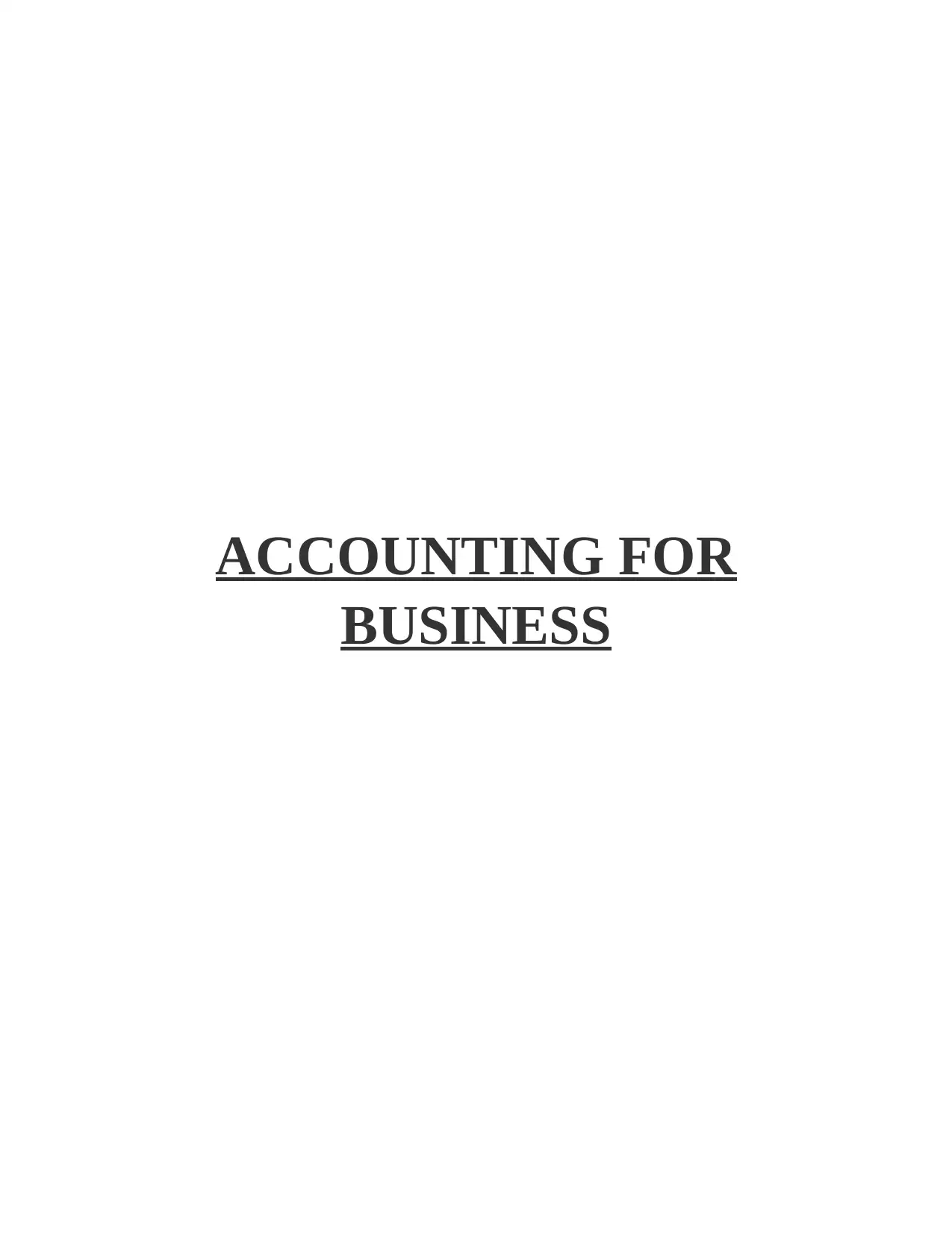
ACCOUNTING FOR
BUSINESS
BUSINESS
Paraphrase This Document
Need a fresh take? Get an instant paraphrase of this document with our AI Paraphraser
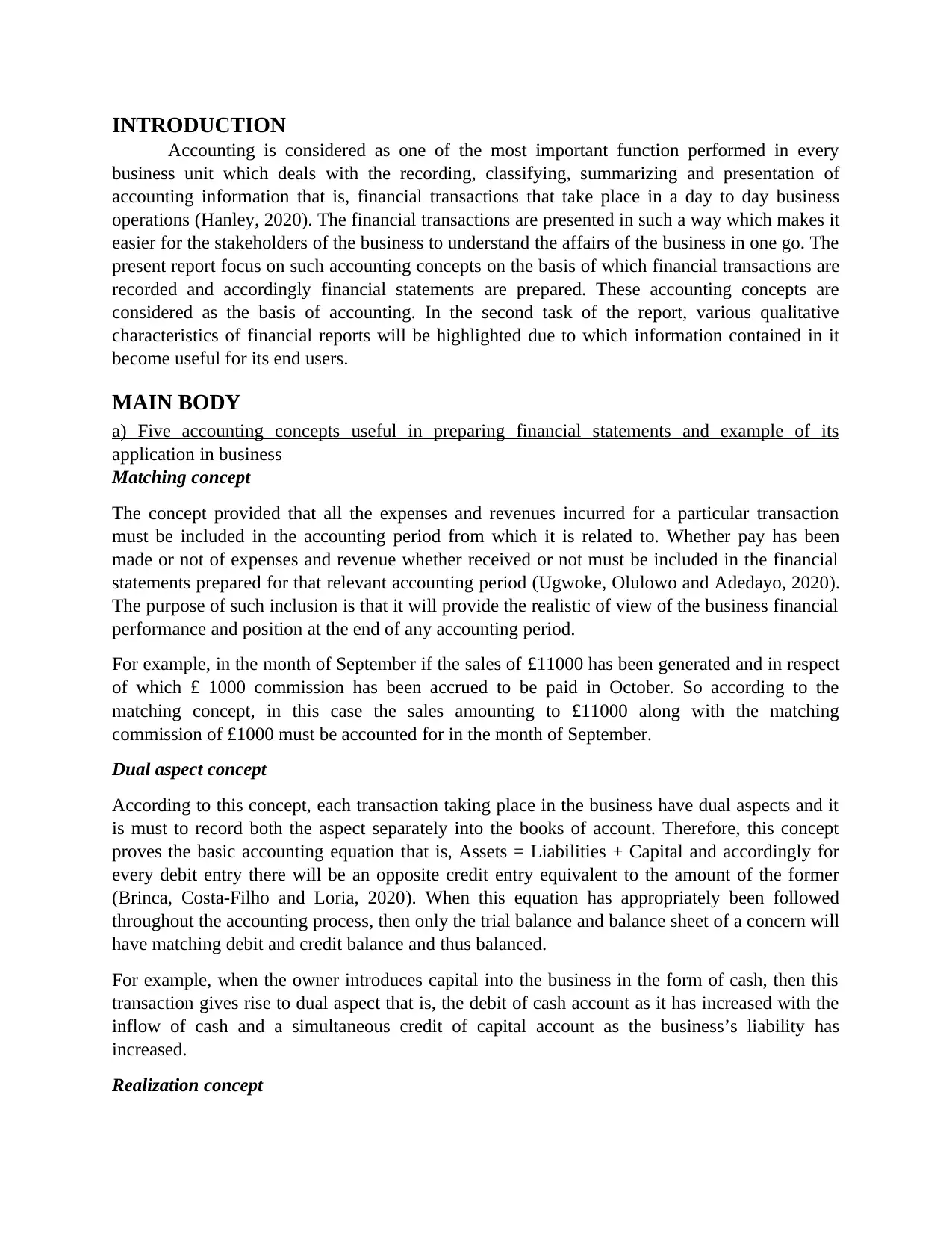
INTRODUCTION
Accounting is considered as one of the most important function performed in every
business unit which deals with the recording, classifying, summarizing and presentation of
accounting information that is, financial transactions that take place in a day to day business
operations (Hanley, 2020). The financial transactions are presented in such a way which makes it
easier for the stakeholders of the business to understand the affairs of the business in one go. The
present report focus on such accounting concepts on the basis of which financial transactions are
recorded and accordingly financial statements are prepared. These accounting concepts are
considered as the basis of accounting. In the second task of the report, various qualitative
characteristics of financial reports will be highlighted due to which information contained in it
become useful for its end users.
MAIN BODY
a) Five accounting concepts useful in preparing financial statements and example of its
application in business
Matching concept
The concept provided that all the expenses and revenues incurred for a particular transaction
must be included in the accounting period from which it is related to. Whether pay has been
made or not of expenses and revenue whether received or not must be included in the financial
statements prepared for that relevant accounting period (Ugwoke, Olulowo and Adedayo, 2020).
The purpose of such inclusion is that it will provide the realistic of view of the business financial
performance and position at the end of any accounting period.
For example, in the month of September if the sales of £11000 has been generated and in respect
of which £ 1000 commission has been accrued to be paid in October. So according to the
matching concept, in this case the sales amounting to £11000 along with the matching
commission of £1000 must be accounted for in the month of September.
Dual aspect concept
According to this concept, each transaction taking place in the business have dual aspects and it
is must to record both the aspect separately into the books of account. Therefore, this concept
proves the basic accounting equation that is, Assets = Liabilities + Capital and accordingly for
every debit entry there will be an opposite credit entry equivalent to the amount of the former
(Brinca, Costa-Filho and Loria, 2020). When this equation has appropriately been followed
throughout the accounting process, then only the trial balance and balance sheet of a concern will
have matching debit and credit balance and thus balanced.
For example, when the owner introduces capital into the business in the form of cash, then this
transaction gives rise to dual aspect that is, the debit of cash account as it has increased with the
inflow of cash and a simultaneous credit of capital account as the business’s liability has
increased.
Realization concept
Accounting is considered as one of the most important function performed in every
business unit which deals with the recording, classifying, summarizing and presentation of
accounting information that is, financial transactions that take place in a day to day business
operations (Hanley, 2020). The financial transactions are presented in such a way which makes it
easier for the stakeholders of the business to understand the affairs of the business in one go. The
present report focus on such accounting concepts on the basis of which financial transactions are
recorded and accordingly financial statements are prepared. These accounting concepts are
considered as the basis of accounting. In the second task of the report, various qualitative
characteristics of financial reports will be highlighted due to which information contained in it
become useful for its end users.
MAIN BODY
a) Five accounting concepts useful in preparing financial statements and example of its
application in business
Matching concept
The concept provided that all the expenses and revenues incurred for a particular transaction
must be included in the accounting period from which it is related to. Whether pay has been
made or not of expenses and revenue whether received or not must be included in the financial
statements prepared for that relevant accounting period (Ugwoke, Olulowo and Adedayo, 2020).
The purpose of such inclusion is that it will provide the realistic of view of the business financial
performance and position at the end of any accounting period.
For example, in the month of September if the sales of £11000 has been generated and in respect
of which £ 1000 commission has been accrued to be paid in October. So according to the
matching concept, in this case the sales amounting to £11000 along with the matching
commission of £1000 must be accounted for in the month of September.
Dual aspect concept
According to this concept, each transaction taking place in the business have dual aspects and it
is must to record both the aspect separately into the books of account. Therefore, this concept
proves the basic accounting equation that is, Assets = Liabilities + Capital and accordingly for
every debit entry there will be an opposite credit entry equivalent to the amount of the former
(Brinca, Costa-Filho and Loria, 2020). When this equation has appropriately been followed
throughout the accounting process, then only the trial balance and balance sheet of a concern will
have matching debit and credit balance and thus balanced.
For example, when the owner introduces capital into the business in the form of cash, then this
transaction gives rise to dual aspect that is, the debit of cash account as it has increased with the
inflow of cash and a simultaneous credit of capital account as the business’s liability has
increased.
Realization concept
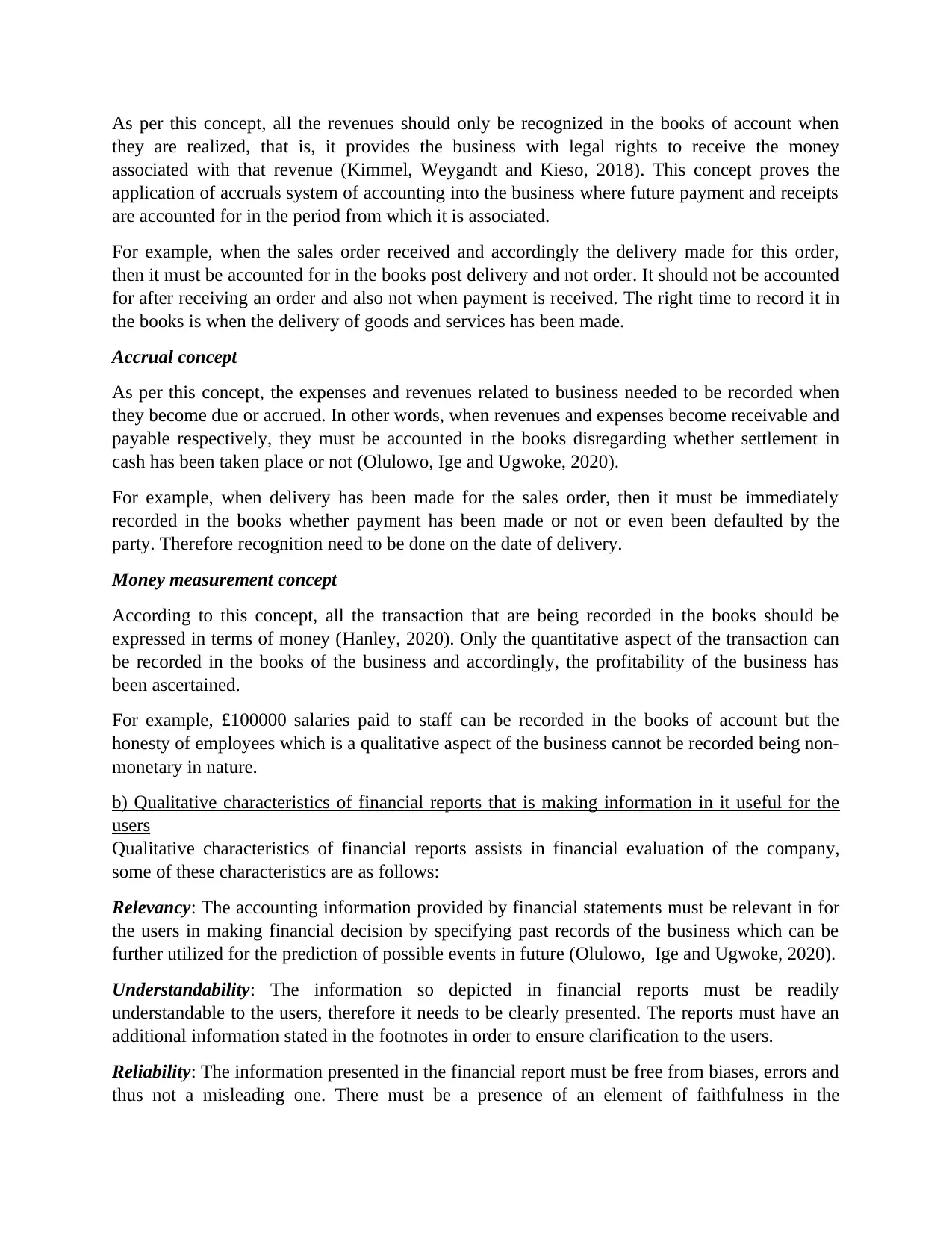
As per this concept, all the revenues should only be recognized in the books of account when
they are realized, that is, it provides the business with legal rights to receive the money
associated with that revenue (Kimmel, Weygandt and Kieso, 2018). This concept proves the
application of accruals system of accounting into the business where future payment and receipts
are accounted for in the period from which it is associated.
For example, when the sales order received and accordingly the delivery made for this order,
then it must be accounted for in the books post delivery and not order. It should not be accounted
for after receiving an order and also not when payment is received. The right time to record it in
the books is when the delivery of goods and services has been made.
Accrual concept
As per this concept, the expenses and revenues related to business needed to be recorded when
they become due or accrued. In other words, when revenues and expenses become receivable and
payable respectively, they must be accounted in the books disregarding whether settlement in
cash has been taken place or not (Olulowo, Ige and Ugwoke, 2020).
For example, when delivery has been made for the sales order, then it must be immediately
recorded in the books whether payment has been made or not or even been defaulted by the
party. Therefore recognition need to be done on the date of delivery.
Money measurement concept
According to this concept, all the transaction that are being recorded in the books should be
expressed in terms of money (Hanley, 2020). Only the quantitative aspect of the transaction can
be recorded in the books of the business and accordingly, the profitability of the business has
been ascertained.
For example, £100000 salaries paid to staff can be recorded in the books of account but the
honesty of employees which is a qualitative aspect of the business cannot be recorded being non-
monetary in nature.
b) Qualitative characteristics of financial reports that is making information in it useful for the
users
Qualitative characteristics of financial reports assists in financial evaluation of the company,
some of these characteristics are as follows:
Relevancy: The accounting information provided by financial statements must be relevant in for
the users in making financial decision by specifying past records of the business which can be
further utilized for the prediction of possible events in future (Olulowo, Ige and Ugwoke, 2020).
Understandability: The information so depicted in financial reports must be readily
understandable to the users, therefore it needs to be clearly presented. The reports must have an
additional information stated in the footnotes in order to ensure clarification to the users.
Reliability: The information presented in the financial report must be free from biases, errors and
thus not a misleading one. There must be a presence of an element of faithfulness in the
they are realized, that is, it provides the business with legal rights to receive the money
associated with that revenue (Kimmel, Weygandt and Kieso, 2018). This concept proves the
application of accruals system of accounting into the business where future payment and receipts
are accounted for in the period from which it is associated.
For example, when the sales order received and accordingly the delivery made for this order,
then it must be accounted for in the books post delivery and not order. It should not be accounted
for after receiving an order and also not when payment is received. The right time to record it in
the books is when the delivery of goods and services has been made.
Accrual concept
As per this concept, the expenses and revenues related to business needed to be recorded when
they become due or accrued. In other words, when revenues and expenses become receivable and
payable respectively, they must be accounted in the books disregarding whether settlement in
cash has been taken place or not (Olulowo, Ige and Ugwoke, 2020).
For example, when delivery has been made for the sales order, then it must be immediately
recorded in the books whether payment has been made or not or even been defaulted by the
party. Therefore recognition need to be done on the date of delivery.
Money measurement concept
According to this concept, all the transaction that are being recorded in the books should be
expressed in terms of money (Hanley, 2020). Only the quantitative aspect of the transaction can
be recorded in the books of the business and accordingly, the profitability of the business has
been ascertained.
For example, £100000 salaries paid to staff can be recorded in the books of account but the
honesty of employees which is a qualitative aspect of the business cannot be recorded being non-
monetary in nature.
b) Qualitative characteristics of financial reports that is making information in it useful for the
users
Qualitative characteristics of financial reports assists in financial evaluation of the company,
some of these characteristics are as follows:
Relevancy: The accounting information provided by financial statements must be relevant in for
the users in making financial decision by specifying past records of the business which can be
further utilized for the prediction of possible events in future (Olulowo, Ige and Ugwoke, 2020).
Understandability: The information so depicted in financial reports must be readily
understandable to the users, therefore it needs to be clearly presented. The reports must have an
additional information stated in the footnotes in order to ensure clarification to the users.
Reliability: The information presented in the financial report must be free from biases, errors and
thus not a misleading one. There must be a presence of an element of faithfulness in the
⊘ This is a preview!⊘
Do you want full access?
Subscribe today to unlock all pages.

Trusted by 1+ million students worldwide
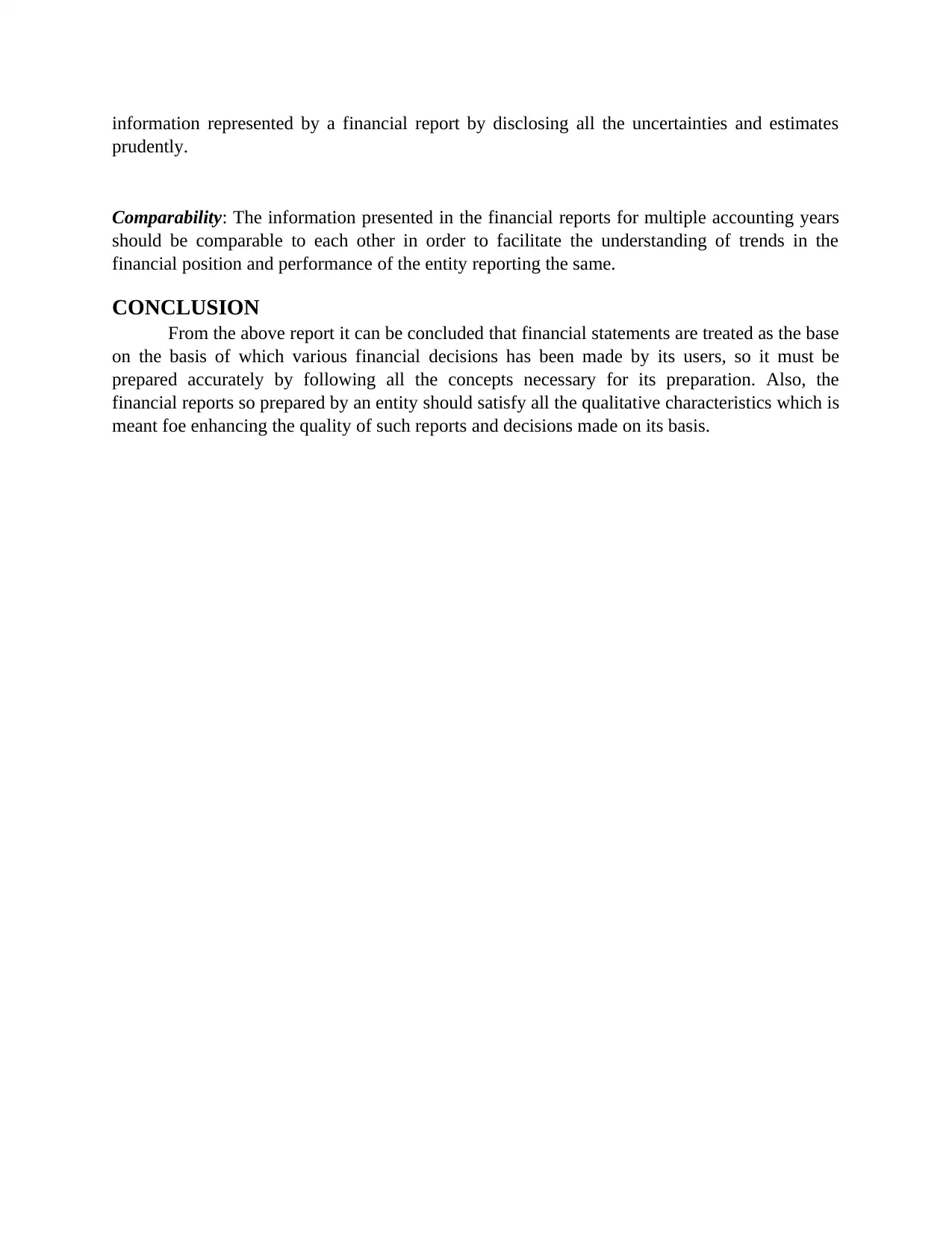
information represented by a financial report by disclosing all the uncertainties and estimates
prudently.
Comparability: The information presented in the financial reports for multiple accounting years
should be comparable to each other in order to facilitate the understanding of trends in the
financial position and performance of the entity reporting the same.
CONCLUSION
From the above report it can be concluded that financial statements are treated as the base
on the basis of which various financial decisions has been made by its users, so it must be
prepared accurately by following all the concepts necessary for its preparation. Also, the
financial reports so prepared by an entity should satisfy all the qualitative characteristics which is
meant foe enhancing the quality of such reports and decisions made on its basis.
prudently.
Comparability: The information presented in the financial reports for multiple accounting years
should be comparable to each other in order to facilitate the understanding of trends in the
financial position and performance of the entity reporting the same.
CONCLUSION
From the above report it can be concluded that financial statements are treated as the base
on the basis of which various financial decisions has been made by its users, so it must be
prepared accurately by following all the concepts necessary for its preparation. Also, the
financial reports so prepared by an entity should satisfy all the qualitative characteristics which is
meant foe enhancing the quality of such reports and decisions made on its basis.
Paraphrase This Document
Need a fresh take? Get an instant paraphrase of this document with our AI Paraphraser
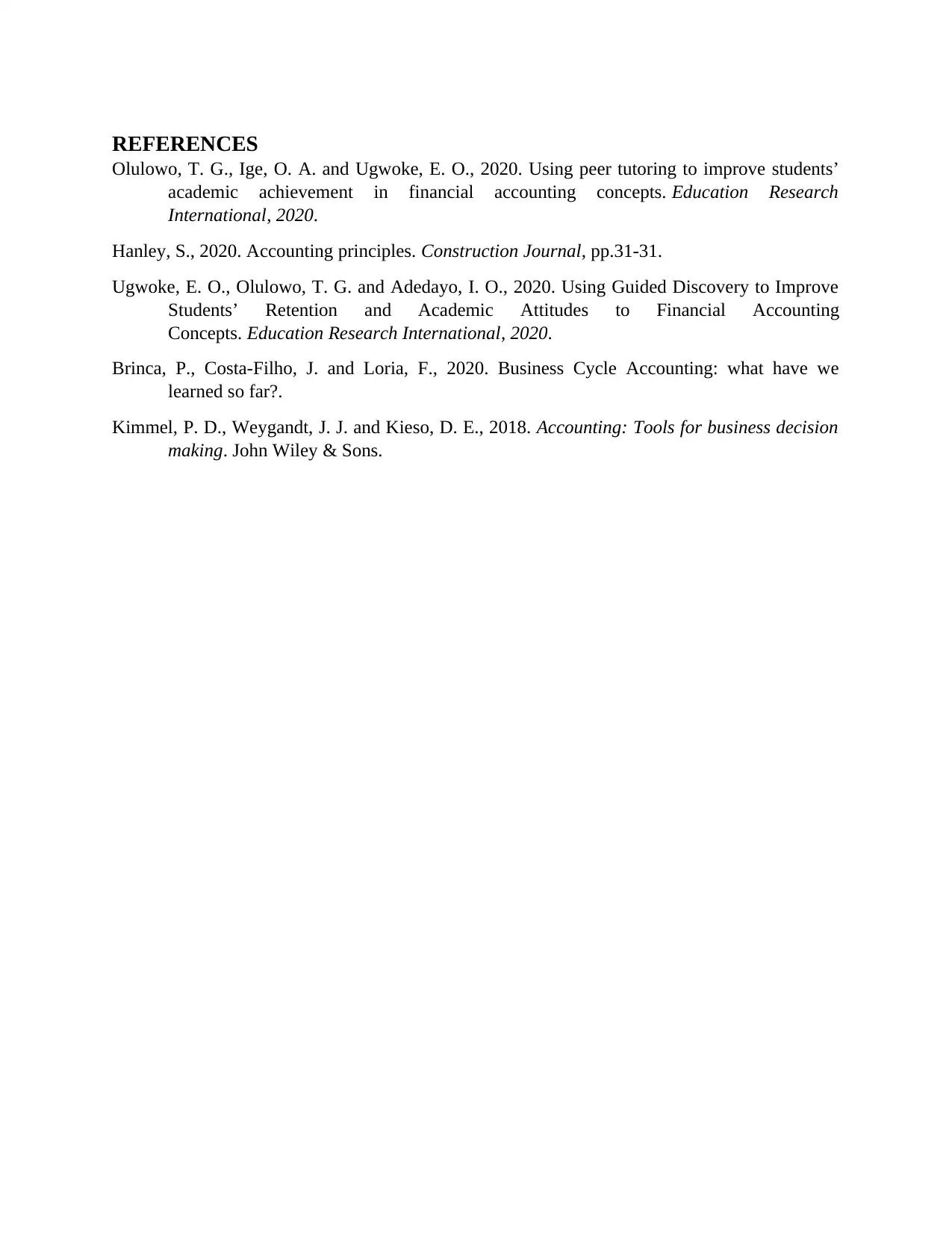
REFERENCES
Olulowo, T. G., Ige, O. A. and Ugwoke, E. O., 2020. Using peer tutoring to improve students’
academic achievement in financial accounting concepts. Education Research
International, 2020.
Hanley, S., 2020. Accounting principles. Construction Journal, pp.31-31.
Ugwoke, E. O., Olulowo, T. G. and Adedayo, I. O., 2020. Using Guided Discovery to Improve
Students’ Retention and Academic Attitudes to Financial Accounting
Concepts. Education Research International, 2020.
Brinca, P., Costa-Filho, J. and Loria, F., 2020. Business Cycle Accounting: what have we
learned so far?.
Kimmel, P. D., Weygandt, J. J. and Kieso, D. E., 2018. Accounting: Tools for business decision
making. John Wiley & Sons.
Olulowo, T. G., Ige, O. A. and Ugwoke, E. O., 2020. Using peer tutoring to improve students’
academic achievement in financial accounting concepts. Education Research
International, 2020.
Hanley, S., 2020. Accounting principles. Construction Journal, pp.31-31.
Ugwoke, E. O., Olulowo, T. G. and Adedayo, I. O., 2020. Using Guided Discovery to Improve
Students’ Retention and Academic Attitudes to Financial Accounting
Concepts. Education Research International, 2020.
Brinca, P., Costa-Filho, J. and Loria, F., 2020. Business Cycle Accounting: what have we
learned so far?.
Kimmel, P. D., Weygandt, J. J. and Kieso, D. E., 2018. Accounting: Tools for business decision
making. John Wiley & Sons.
1 out of 5
Related Documents
Your All-in-One AI-Powered Toolkit for Academic Success.
+13062052269
info@desklib.com
Available 24*7 on WhatsApp / Email
![[object Object]](/_next/static/media/star-bottom.7253800d.svg)
Unlock your academic potential
Copyright © 2020–2025 A2Z Services. All Rights Reserved. Developed and managed by ZUCOL.



